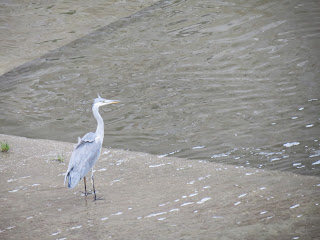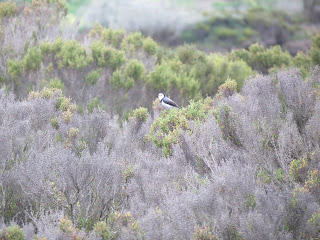Many visitors to Melbourne may not have time to go far away from the inner city and surrounds, so here is a list of good birding spots that aren't too far from the inner city. I have noted the ones I have not visited yet.
A black-winged stilt at the first lake of Westgate Park
WESTGATE PARK
This park is next to the Westgate Bridge, and contains several lakes.
Eurasian coots, dusky moorhens, purple swamphens, Pacific black ducks, black swans, Australasian grebes, hoary-headed grebes, chestnut teals, grey teals, black-winged stilts, eastern great egrets, royal spoonbills, hardheads and
silver gulls are all fairly common in the lakes.
Superb fairy-wrens, striated pardalotes, white-plumed honeyeaters, grey fantails, New Holland honeyeaters and similar may also be seen in the surrounding trees. There are other posts about this location on this blog.
STONY CREEK BACKWASH
On the other side of the Westgate Bridge, this small park contains a rare stand of white mangroves, as well as the shipwreck of a barge. Look for
little black cormorants, eastern great egrets, silver gulls, great crested terns, little pied cormorants, chestnut teals, grey teals and
Pacific black ducks in the backwash and flying overhead. There may also be
New Holland honeyeaters in the mangroves.
MELBOURNE ZOO
A breeding plumage Nankeen night heron at Pelican Lake
The grounds of the Melbourne Zoo can be good for birds. The main spot is Pelican Lake, in the Asian Rainforest section of the zoo. Though the pelicans here are captive birds, wild
Nankeen night herons and
great cormorants are almost guaranteed here.
Grey teals, chestnut teals, silver gulls, little pied cormorants and
Pacific black ducks can also be seen. In the surrounding trees look for introduced
song thrushes and
common blackbirds on the ground. At certain spots in the zoo introduced
Eurasian tree sparrows can also be seen. In the Australian Bush section look out for
little wattlebirds, red wattlebirds, rainbow lorikeets, noisy miners and
bell miners. Sometimes
laughing kookaburras can be seen perched in the trees near the Bongo Exhibit. In bushy parts of the zoo look out for
grey fantails, superb fairy-wrens, eastern spinebills, white-browed scrubwrens and
silvereyes. There is also a colony of
bell miners near the carpark. In winter trees around the zoo are full of
rainbow lorikeets, little lorikeets and
musk lorikeets. Swift parrots occasionally visit as well. Throughout the zoo look out for
silver gulls, house sparrows, rainbow lorikeets, common mynas and
spotted turtledoves. There are other posts about this location on this blog.
In Australia song thrushes can only be found in Victoria, where they have been introduced to Melbourne and the surrounding area
ROYAL PARK (not visited)
The park surrounding the Melbourne Zoo is also a good spot, but I cannot find much information on it so only some of the birds possible are listed here. The Trin-Warren Tam-Boore wetlands are home to various waterbirds including
chestnut teals, hardheads, purple swamphens, dusky moorhens, Eurasian coots, grey teals, Pacific black ducks, silver gulls and similar. Around the area look for
Australian reed warblers and
little grassbirds. A bushy area has been set up for the protection of White's Skinks, here various birds can be seen including
grey fantails, little wattlebirds, crested pigeons, red wattlebirds, superb fairy-wrens, eastern spinebills, white-browed scrubwrens, red-rumped parrots, rainbow lorikeets, white-plumed honeyeaters, NEW Holland honeyeaters, noisy miners, eastern spinebills, spotted pardalotes, Willie wagtails, bell miners and
silvereyes, among others. Further on are deeper ponds, where some different waterbirds can be seen. Sometimes raptors can be seen flying overhead.
MELBOURNE BOTANIC GARDENS
Hoary-headed grebes are fairly common at the Botanic Gardens lake
The lake in the middle of the gardens is home to
little black cormorants, Nankeen night herons, Pacific black ducks, chestnut teals, dusky moorhens, black swans, silver gulls, purple swamphens, Eurasian coots, grey teals and
hoary-headed grebes. Throughout the gardens look for
brown thornbills, magpie-larks, Australian magpies, common blackbirds, little wattlebirds, red wattlebirds, bell miners, common mynas, little ravens and
house sparrows. There are other posts about this location on this blog.
YARRA BEND PARK (not visited)
This park near the city is a good site for
tawny frogmouths and
southern boobooks at night. Various bush birds and waterbirds can also be seen in the park and surrounds.
Nankeen night herons, laughing kookaburras, grey butcherbirds, Australian magpies, spotted pardalotes, Australian wood ducks, Pacific black ducks, eastern rosellas, eastern spinebills, bell miners, white-plumed honeyeaters, New Holland honeyeaters, red wattlebirds, little wattlebirds, noisy miners, white-browed scrubwrens, brown thornbills, black-faced cuckooshrikes and
grey shrike-thrushes are some of the birds other people have recorded.
The Australian reed warbler, also known as the Clamorous reed warbler, can sometimes be seen in reeds on Herring Island
HERRING ISLAND (not visited)
This small island is located in the Yarra Rver, about 3 kilometres from the city. You can only access the island by boat. Parks Victoria runs a boat across the river during summer. On the jetty you can see
little pied cormorants, dusky moorhens, Australian reed warblers and
Pacific black ducks. The first boat arrives at 11 am.
Rainbow lorikeets, grey butcherbirds, red-rumped parrots, willie wagtails, superb fairy-wrens, welcome swallows, Australian magpies, noisy miners, white-plumed honeyeaters and
brown goshawks are some birds other people have recorded on the island.
THE REST OF THE CITY
Throughout much of Melbourne
house sparrows, feral pigeons, silver gulls and
common mynas are abundant. Along the Yarra River
silver gulls are the commonest birds, but I have also recorded
little black cormorants (uncommon),
little pied cormorants (uncommon),
black swans (rare) and
mallards (rare)
.























































